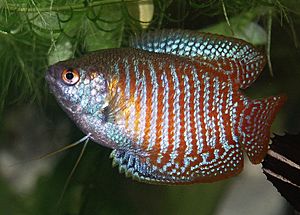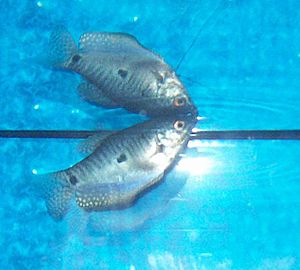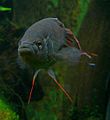Gourami facts for kids
Quick facts for kids Gouramis |
|
|---|---|
 |
|
| Dwarf gourami (Trichogaster lalius) | |
| Scientific classification |
|
| Kingdom: | Animalia |
| Phylum: | Chordata |
| Class: | Actinopterygii |
| Order: | Anabantiformes |
| Suborder: | Anabantoidei |
| Family: | Osphronemidae van der Hoeven, 1832 |
| Subfamilies & genera | |
|
see text |
|
Gouramis are a group of freshwater fish that belong to the family Osphronemidae. These fish come from Asia, found in places like Pakistan, India, Southeast Asia, and even up to Korea. The name "gourami" comes from Indonesia.
Many gouramis have special long, thin fins at the front of their bodies. These fins look a bit like feelers. All living gourami species take care of their babies. Some are mouthbrooders, meaning they keep their eggs and young fish safe in their mouths. Others, like the Siamese fighting fish (Betta splendens), build special bubble nests on the water's surface for their eggs. There are about 133 known species of gouramis today.
Gouramis are also known as "labyrinth fish." This is because they have a special organ, like a small lung, that lets them breathe air from above the water. This is super helpful for them because they often live in warm, shallow water where there isn't much oxygen.
Contents
Types of Gouramis
The gourami family, Osphronemidae, is divided into different groups called subfamilies and genera. Think of it like a big family tree with many branches! Some of the main groups include:
- Subfamily Belontiinae
- Subfamily Osphroneminae
- Subfamily Luciocephalinae
- Subfamily Macropodusinae
- Subfamily Trichogastrinae
Each of these subfamilies contains different types of gourami fish. For example, the famous Betta fish belongs to the Macropodusinae subfamily.
Gouramis as Food
Giant gouramis, known scientifically as Osphronemus goramy, are eaten in some parts of the world. In countries like Malaysia, Indonesia, and Thailand, these fish are often deep-fried. They are served with tasty sauces like sweet-sour sauce or chili sauce.
The paradise fish (Macropodus opercularis) is another type of gourami that is popular for food. In China, these fish are even canned and sold in Asian supermarkets around the world. Gouramis are especially popular in Sundanese cuisine in Indonesia. People often catch these gouramis in streams, rivers, and canals in Southeast Asia.
Gouramis in Aquariums

Many types of gouramis are very popular as pet fish in home aquariums. Because they are "labyrinth fish," they often swim near the top of the tank to breathe air. Just like other tropical fish, they usually need an aquarium heater to keep their water warm.
Gouramis can eat different kinds of fish food, including flakes or live foods. Some gourami species can grow very large, so they might not be suitable for every home aquarium.
Living with Other Fish
Big gouramis can sometimes be a bit bossy, especially with other colorful fish or fish that are about their same size. If you want to have a community tank with different types of fish, it's a good idea to ask for advice at a pet store.
Gouramis might sometimes nip at other fish's fins. If you have baby fish (called fry) in your tank, gouramis will likely eat them. In this case, it's best to move the baby fish to a separate breeding tank to keep them safe.
Generally, gouramis are seen as peaceful fish. However, adult males might sometimes fight with each other. Too many fish in one tank can also make them more aggressive.
Gouramis can live with many other fish species. These include danios, mollies, silver dollars, Neon tetras, and plecostomus catfish. How well they get along depends on the specific type of gourami and the other fish in the tank. Some gouramis, like those in the Macropodus or Belontia groups, can be very aggressive. They might bother or even eat smaller fish. Other types, like Parosphromenus and Sphaerichthys, are very shy and need special water conditions. They might struggle to compete with more common community fish.
Images for kids
-
Female and male dwarf gouramis (Trichogaster lalius) showing how they look different (this is called sexual dimorphism).
-
Paradise fish (Macropodus opercularis)
-
Giant gourami (Osphronemus goramy)
-
Three spot gourami (Trichopodus trichopterus)
-
Gold gourami
A special color variation of Trichopodus trichopterus.
See also
 In Spanish: Osphronemidae para niños
In Spanish: Osphronemidae para niños







